University Report: DTGOV Cloud Transformation and Microservices
VerifiedAdded on 2022/11/25
|9
|1280
|325
Report
AI Summary
This report provides an analysis of DTGOV's cloud transformation strategy, focusing on the implementation of a microservices architecture. It begins by outlining DTGOV's requirements, including the need for increased flexibility, responsiveness, and cost savings through the adoption of a hybrid cloud model. The report then delves into the proposed microservices architecture, explaining how it can enable efficient resource management and streamlined service development. The benefits of microservices, such as improved scaling, resilience, and team-based optimization, are discussed. The report also addresses potential issues, including changes in development mindset and the complexities of organizing services. Ultimately, the report concludes by summarizing the key aspects of DTGOV's cloud transformation and the implications of adopting a microservices approach.
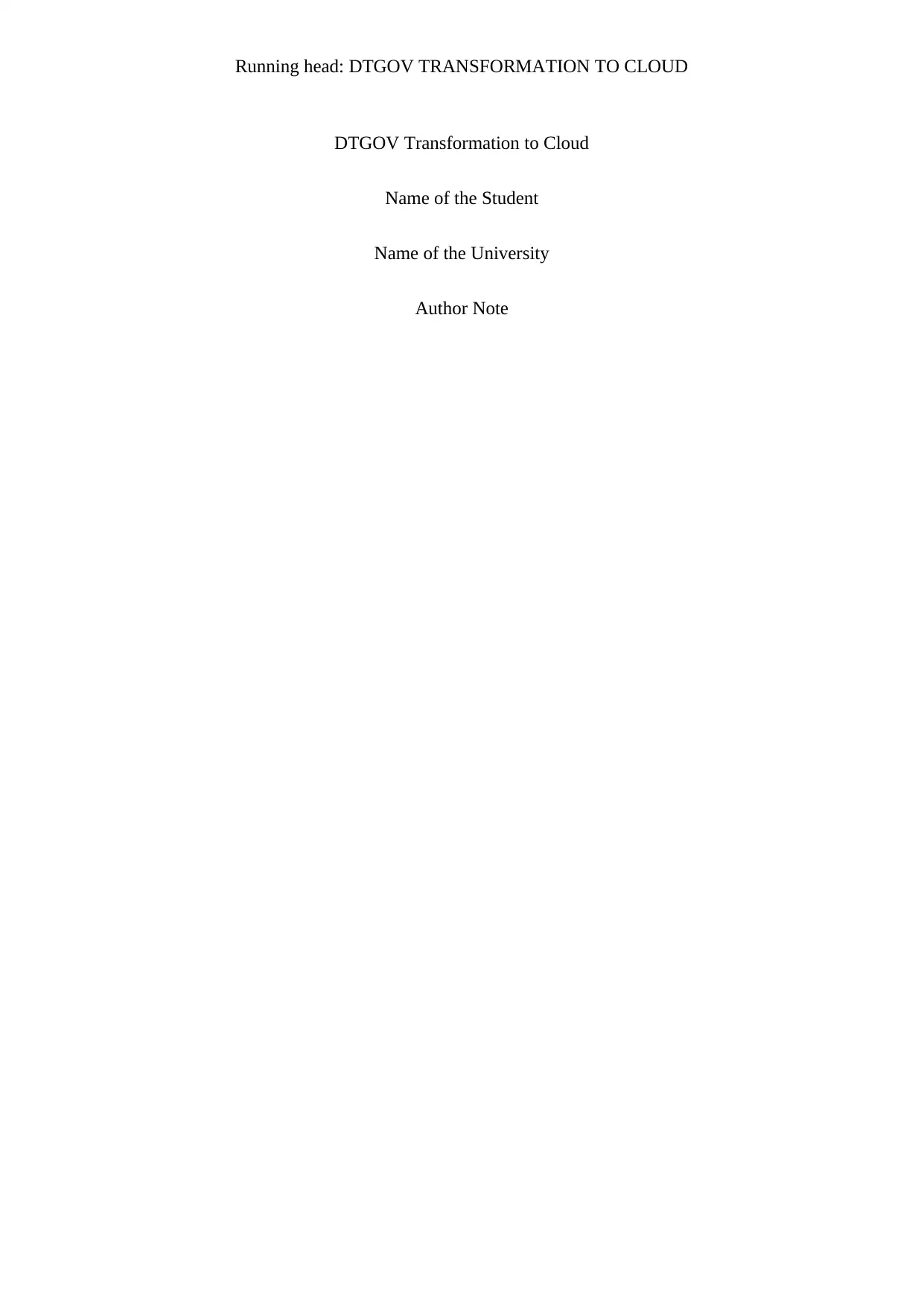
Running head: DTGOV TRANSFORMATION TO CLOUD
DTGOV Transformation to Cloud
Name of the Student
Name of the University
Author Note
DTGOV Transformation to Cloud
Name of the Student
Name of the University
Author Note
Paraphrase This Document
Need a fresh take? Get an instant paraphrase of this document with our AI Paraphraser

1
DTGOV TRANSFORMATION TO CLOUD
Summary
The purpose of this report is about identifying the requirements of DTGOV and based on
which suggesting a cloud architecture that can bring more efficiency in production. After
talking about the requirements the report directly jumps to the cloud architecture which is
chosen to be microservices. Then the architecture and gets explaining how it helps DTGOV.
Thereafter the benefits and issues get discussed and the report ends with concluding notes.
DTGOV TRANSFORMATION TO CLOUD
Summary
The purpose of this report is about identifying the requirements of DTGOV and based on
which suggesting a cloud architecture that can bring more efficiency in production. After
talking about the requirements the report directly jumps to the cloud architecture which is
chosen to be microservices. Then the architecture and gets explaining how it helps DTGOV.
Thereafter the benefits and issues get discussed and the report ends with concluding notes.

2
DTGOV TRANSFORMATION TO CLOUD
Table of Contents
Introduction................................................................................................................................3
Description.................................................................................................................................3
Requirements..........................................................................................................................3
Cloud Architecture.................................................................................................................3
Microservices.....................................................................................................................3
Benefits and Issues of Microservices.....................................................................................4
Benefits..............................................................................................................................4
Issues..................................................................................................................................5
Conclusion..................................................................................................................................5
References..................................................................................................................................7
References..................................................................................................................................8
DTGOV TRANSFORMATION TO CLOUD
Table of Contents
Introduction................................................................................................................................3
Description.................................................................................................................................3
Requirements..........................................................................................................................3
Cloud Architecture.................................................................................................................3
Microservices.....................................................................................................................3
Benefits and Issues of Microservices.....................................................................................4
Benefits..............................................................................................................................4
Issues..................................................................................................................................5
Conclusion..................................................................................................................................5
References..................................................................................................................................7
References..................................................................................................................................8
⊘ This is a preview!⊘
Do you want full access?
Subscribe today to unlock all pages.

Trusted by 1+ million students worldwide
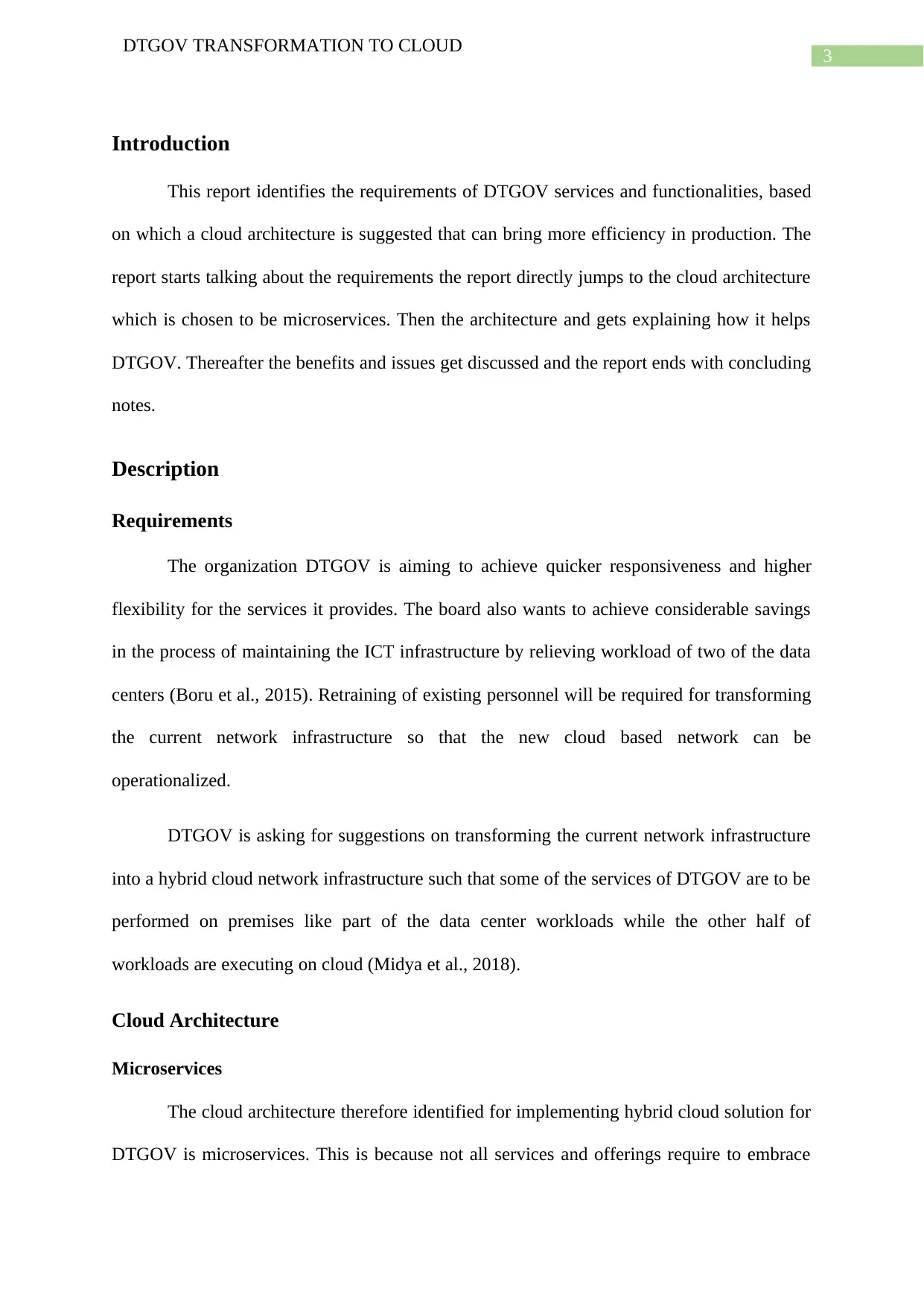
3
DTGOV TRANSFORMATION TO CLOUD
Introduction
This report identifies the requirements of DTGOV services and functionalities, based
on which a cloud architecture is suggested that can bring more efficiency in production. The
report starts talking about the requirements the report directly jumps to the cloud architecture
which is chosen to be microservices. Then the architecture and gets explaining how it helps
DTGOV. Thereafter the benefits and issues get discussed and the report ends with concluding
notes.
Description
Requirements
The organization DTGOV is aiming to achieve quicker responsiveness and higher
flexibility for the services it provides. The board also wants to achieve considerable savings
in the process of maintaining the ICT infrastructure by relieving workload of two of the data
centers (Boru et al., 2015). Retraining of existing personnel will be required for transforming
the current network infrastructure so that the new cloud based network can be
operationalized.
DTGOV is asking for suggestions on transforming the current network infrastructure
into a hybrid cloud network infrastructure such that some of the services of DTGOV are to be
performed on premises like part of the data center workloads while the other half of
workloads are executing on cloud (Midya et al., 2018).
Cloud Architecture
Microservices
The cloud architecture therefore identified for implementing hybrid cloud solution for
DTGOV is microservices. This is because not all services and offerings require to embrace
DTGOV TRANSFORMATION TO CLOUD
Introduction
This report identifies the requirements of DTGOV services and functionalities, based
on which a cloud architecture is suggested that can bring more efficiency in production. The
report starts talking about the requirements the report directly jumps to the cloud architecture
which is chosen to be microservices. Then the architecture and gets explaining how it helps
DTGOV. Thereafter the benefits and issues get discussed and the report ends with concluding
notes.
Description
Requirements
The organization DTGOV is aiming to achieve quicker responsiveness and higher
flexibility for the services it provides. The board also wants to achieve considerable savings
in the process of maintaining the ICT infrastructure by relieving workload of two of the data
centers (Boru et al., 2015). Retraining of existing personnel will be required for transforming
the current network infrastructure so that the new cloud based network can be
operationalized.
DTGOV is asking for suggestions on transforming the current network infrastructure
into a hybrid cloud network infrastructure such that some of the services of DTGOV are to be
performed on premises like part of the data center workloads while the other half of
workloads are executing on cloud (Midya et al., 2018).
Cloud Architecture
Microservices
The cloud architecture therefore identified for implementing hybrid cloud solution for
DTGOV is microservices. This is because not all services and offerings require to embrace
Paraphrase This Document
Need a fresh take? Get an instant paraphrase of this document with our AI Paraphraser

4
DTGOV TRANSFORMATION TO CLOUD
cloud based solutions. Only the services that are most frequently experiencing changes, the
services that are running the most stable as well as the set of services that are attaining their
peak usage loads are the first set of services that can lead to starvation of resources and might
start giving rise to faults or can force DTGOV to acquire more expensive resources. It is
these processes that should be factored first exercise as microservices.
In microservices a process of functionality gets broken down to sub processes and
dynamic allocation of resources to these sub processes enable better management of
resources. It is also essential to make sure that the cloud architecture is properly implemented
as running excess of microservices in systems can result to poor design of APIs and excessive
networking equipment can prevent efficient and effective communication as a result (Villari
et al., 2016). Microservices also enable different sub services to be built using different
programming languages and hence instead of using a single language for all services, the
language ideally suited for a particular service can be chosen. In this way the sub services can
be streamlined thereby improving overall application performance. By deploying containers
microservices ensure efficient consumption of resources. Since these microservices differ
wildly from regular processes, they need to be monitored closely so that the respective
dependencies among the various microservices can be understood more precisely.
Benefits and Issues of Microservices
Benefits
Adoption of microservices can provide a range of benefits. These can be:
Cross-cutting business functionality: Using microservices can eliminate the requirements
of building standardized pieces of service functionalities throughout the company repeatedly
like authentication and management of users.
DTGOV TRANSFORMATION TO CLOUD
cloud based solutions. Only the services that are most frequently experiencing changes, the
services that are running the most stable as well as the set of services that are attaining their
peak usage loads are the first set of services that can lead to starvation of resources and might
start giving rise to faults or can force DTGOV to acquire more expensive resources. It is
these processes that should be factored first exercise as microservices.
In microservices a process of functionality gets broken down to sub processes and
dynamic allocation of resources to these sub processes enable better management of
resources. It is also essential to make sure that the cloud architecture is properly implemented
as running excess of microservices in systems can result to poor design of APIs and excessive
networking equipment can prevent efficient and effective communication as a result (Villari
et al., 2016). Microservices also enable different sub services to be built using different
programming languages and hence instead of using a single language for all services, the
language ideally suited for a particular service can be chosen. In this way the sub services can
be streamlined thereby improving overall application performance. By deploying containers
microservices ensure efficient consumption of resources. Since these microservices differ
wildly from regular processes, they need to be monitored closely so that the respective
dependencies among the various microservices can be understood more precisely.
Benefits and Issues of Microservices
Benefits
Adoption of microservices can provide a range of benefits. These can be:
Cross-cutting business functionality: Using microservices can eliminate the requirements
of building standardized pieces of service functionalities throughout the company repeatedly
like authentication and management of users.
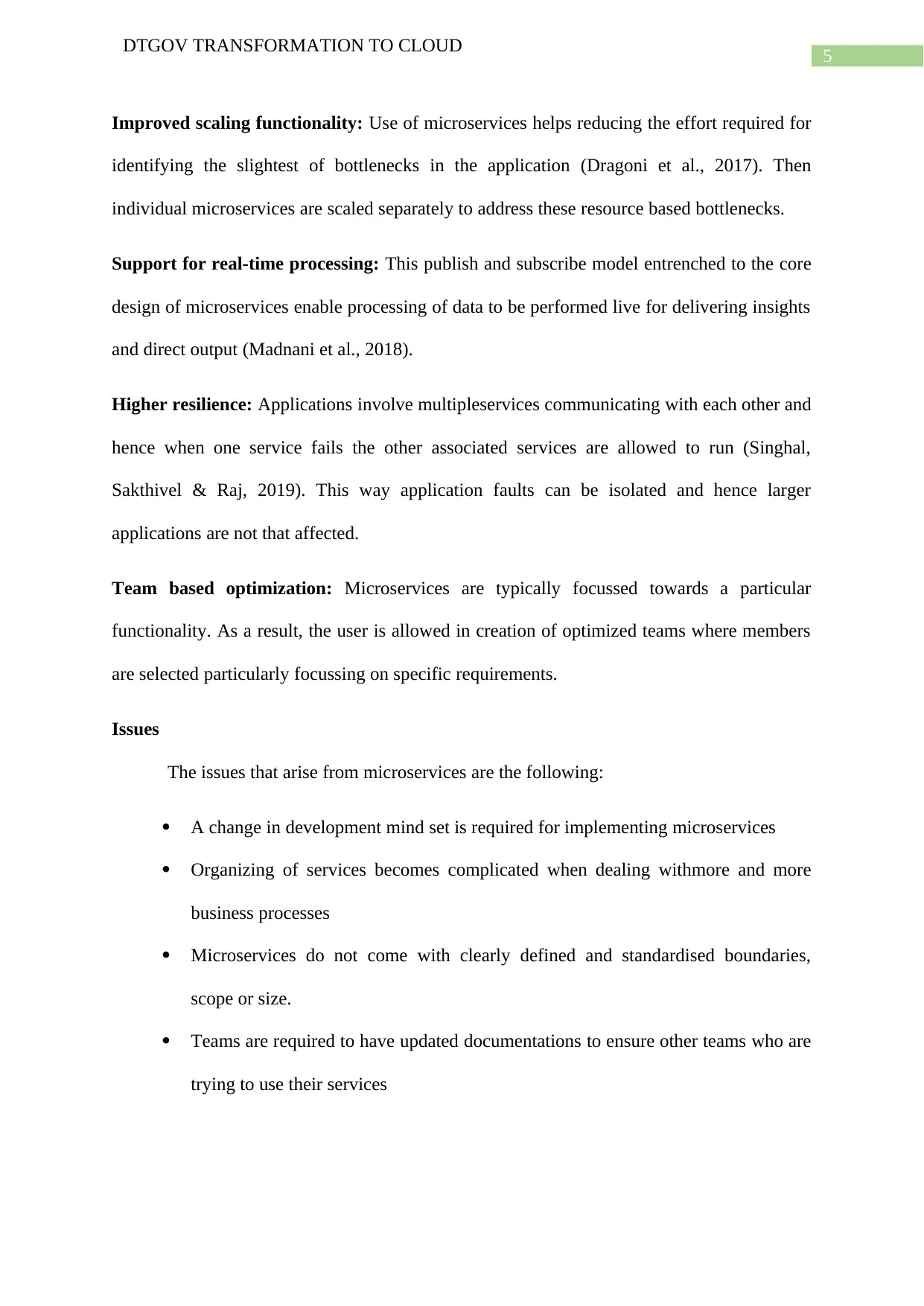
5
DTGOV TRANSFORMATION TO CLOUD
Improved scaling functionality: Use of microservices helps reducing the effort required for
identifying the slightest of bottlenecks in the application (Dragoni et al., 2017). Then
individual microservices are scaled separately to address these resource based bottlenecks.
Support for real-time processing: This publish and subscribe model entrenched to the core
design of microservices enable processing of data to be performed live for delivering insights
and direct output (Madnani et al., 2018).
Higher resilience: Applications involve multipleservices communicating with each other and
hence when one service fails the other associated services are allowed to run (Singhal,
Sakthivel & Raj, 2019). This way application faults can be isolated and hence larger
applications are not that affected.
Team based optimization: Microservices are typically focussed towards a particular
functionality. As a result, the user is allowed in creation of optimized teams where members
are selected particularly focussing on specific requirements.
Issues
The issues that arise from microservices are the following:
A change in development mind set is required for implementing microservices
Organizing of services becomes complicated when dealing withmore and more
business processes
Microservices do not come with clearly defined and standardised boundaries,
scope or size.
Teams are required to have updated documentations to ensure other teams who are
trying to use their services
DTGOV TRANSFORMATION TO CLOUD
Improved scaling functionality: Use of microservices helps reducing the effort required for
identifying the slightest of bottlenecks in the application (Dragoni et al., 2017). Then
individual microservices are scaled separately to address these resource based bottlenecks.
Support for real-time processing: This publish and subscribe model entrenched to the core
design of microservices enable processing of data to be performed live for delivering insights
and direct output (Madnani et al., 2018).
Higher resilience: Applications involve multipleservices communicating with each other and
hence when one service fails the other associated services are allowed to run (Singhal,
Sakthivel & Raj, 2019). This way application faults can be isolated and hence larger
applications are not that affected.
Team based optimization: Microservices are typically focussed towards a particular
functionality. As a result, the user is allowed in creation of optimized teams where members
are selected particularly focussing on specific requirements.
Issues
The issues that arise from microservices are the following:
A change in development mind set is required for implementing microservices
Organizing of services becomes complicated when dealing withmore and more
business processes
Microservices do not come with clearly defined and standardised boundaries,
scope or size.
Teams are required to have updated documentations to ensure other teams who are
trying to use their services
⊘ This is a preview!⊘
Do you want full access?
Subscribe today to unlock all pages.

Trusted by 1+ million students worldwide
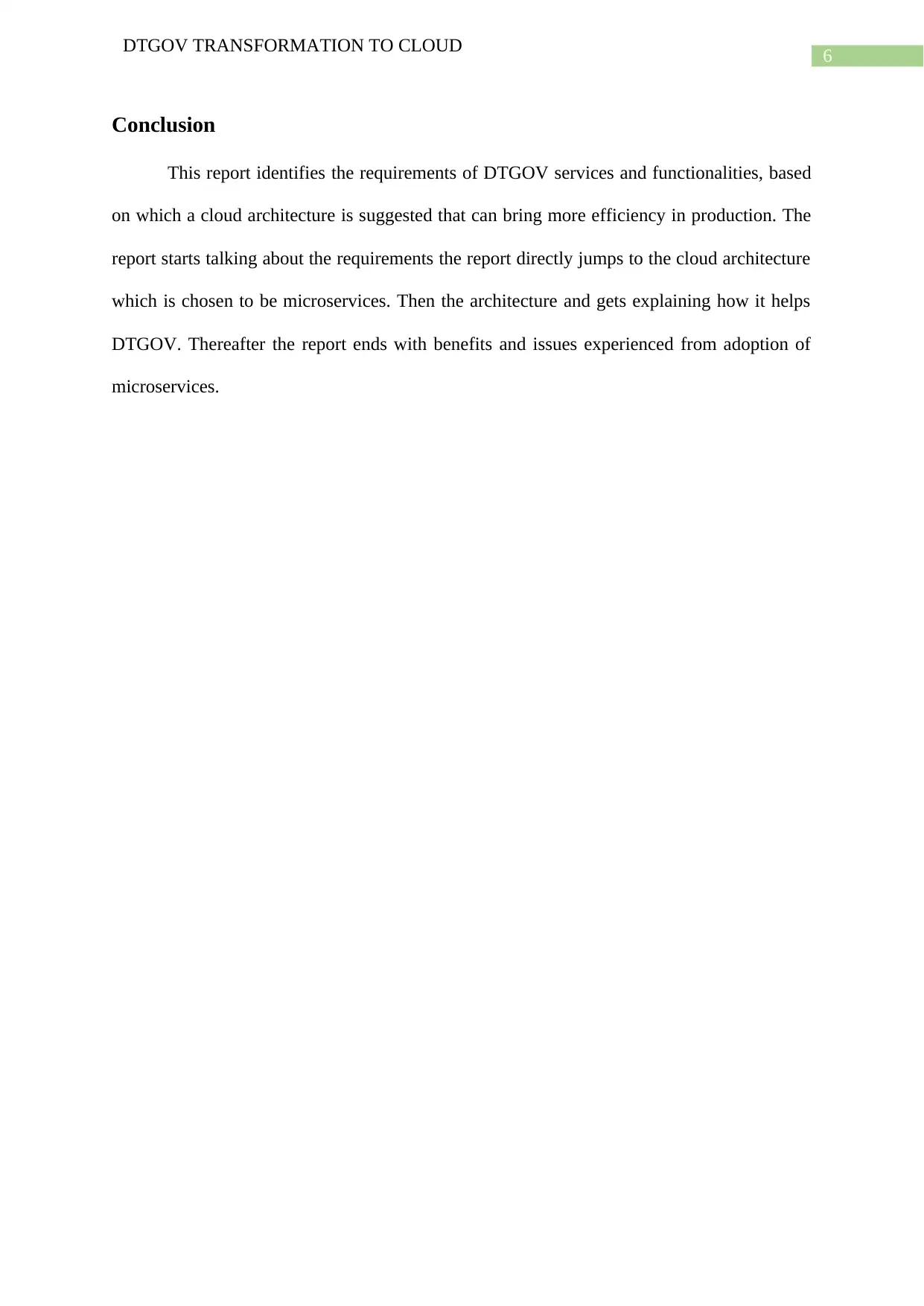
6
DTGOV TRANSFORMATION TO CLOUD
Conclusion
This report identifies the requirements of DTGOV services and functionalities, based
on which a cloud architecture is suggested that can bring more efficiency in production. The
report starts talking about the requirements the report directly jumps to the cloud architecture
which is chosen to be microservices. Then the architecture and gets explaining how it helps
DTGOV. Thereafter the report ends with benefits and issues experienced from adoption of
microservices.
DTGOV TRANSFORMATION TO CLOUD
Conclusion
This report identifies the requirements of DTGOV services and functionalities, based
on which a cloud architecture is suggested that can bring more efficiency in production. The
report starts talking about the requirements the report directly jumps to the cloud architecture
which is chosen to be microservices. Then the architecture and gets explaining how it helps
DTGOV. Thereafter the report ends with benefits and issues experienced from adoption of
microservices.
Paraphrase This Document
Need a fresh take? Get an instant paraphrase of this document with our AI Paraphraser
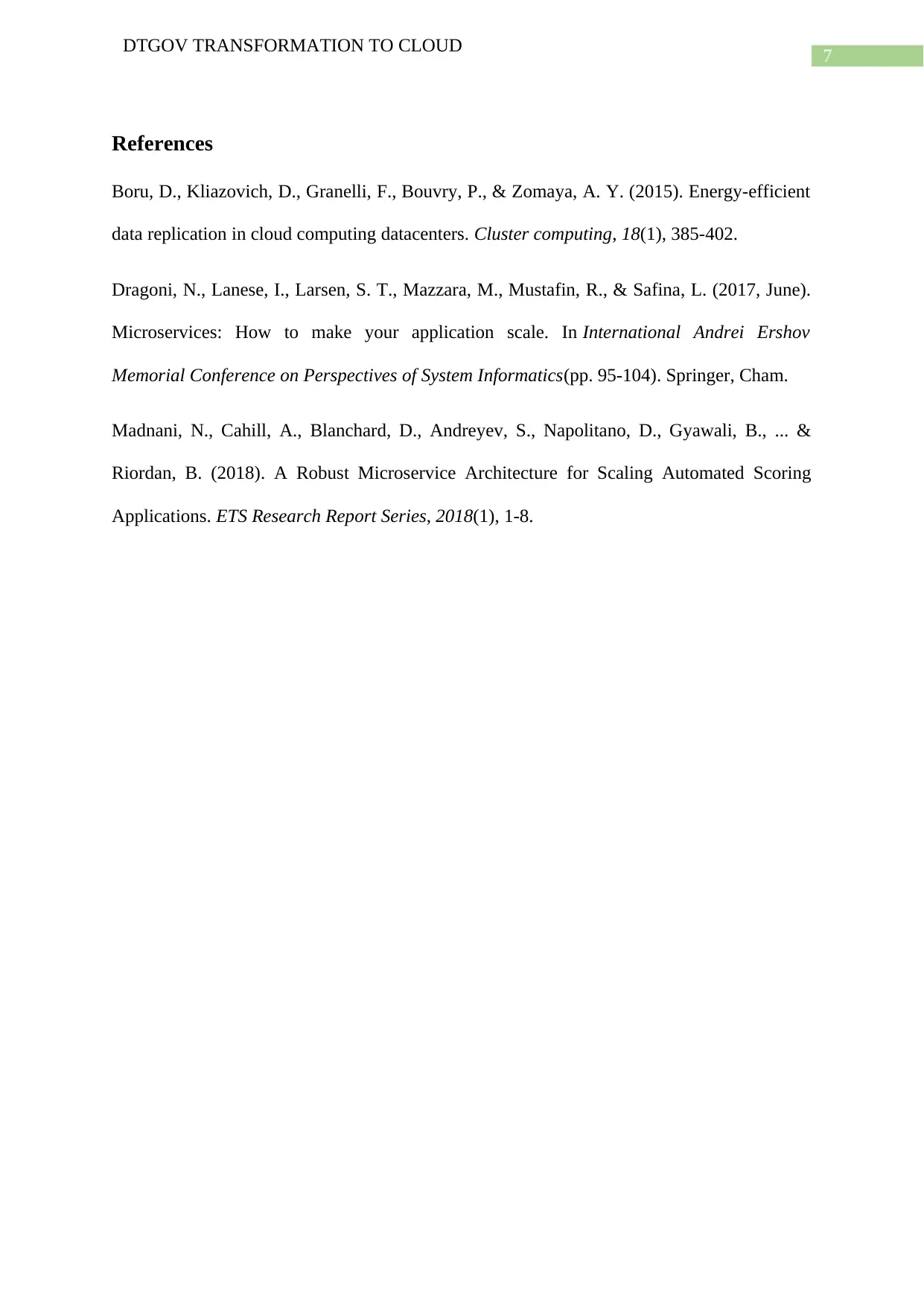
7
DTGOV TRANSFORMATION TO CLOUD
References
Boru, D., Kliazovich, D., Granelli, F., Bouvry, P., & Zomaya, A. Y. (2015). Energy-efficient
data replication in cloud computing datacenters. Cluster computing, 18(1), 385-402.
Dragoni, N., Lanese, I., Larsen, S. T., Mazzara, M., Mustafin, R., & Safina, L. (2017, June).
Microservices: How to make your application scale. In International Andrei Ershov
Memorial Conference on Perspectives of System Informatics(pp. 95-104). Springer, Cham.
Madnani, N., Cahill, A., Blanchard, D., Andreyev, S., Napolitano, D., Gyawali, B., ... &
Riordan, B. (2018). A Robust Microservice Architecture for Scaling Automated Scoring
Applications. ETS Research Report Series, 2018(1), 1-8.
DTGOV TRANSFORMATION TO CLOUD
References
Boru, D., Kliazovich, D., Granelli, F., Bouvry, P., & Zomaya, A. Y. (2015). Energy-efficient
data replication in cloud computing datacenters. Cluster computing, 18(1), 385-402.
Dragoni, N., Lanese, I., Larsen, S. T., Mazzara, M., Mustafin, R., & Safina, L. (2017, June).
Microservices: How to make your application scale. In International Andrei Ershov
Memorial Conference on Perspectives of System Informatics(pp. 95-104). Springer, Cham.
Madnani, N., Cahill, A., Blanchard, D., Andreyev, S., Napolitano, D., Gyawali, B., ... &
Riordan, B. (2018). A Robust Microservice Architecture for Scaling Automated Scoring
Applications. ETS Research Report Series, 2018(1), 1-8.
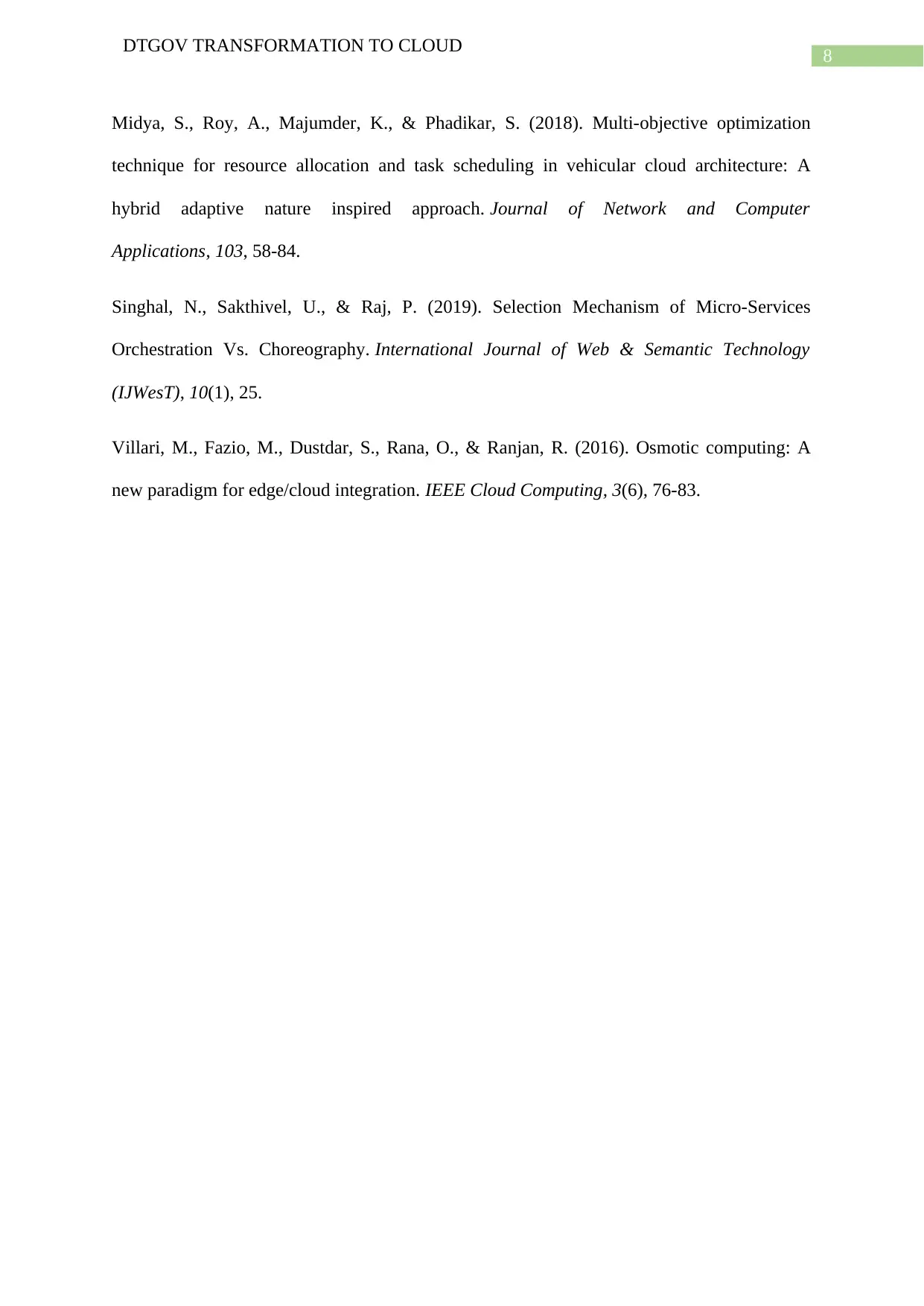
8
DTGOV TRANSFORMATION TO CLOUD
Midya, S., Roy, A., Majumder, K., & Phadikar, S. (2018). Multi-objective optimization
technique for resource allocation and task scheduling in vehicular cloud architecture: A
hybrid adaptive nature inspired approach. Journal of Network and Computer
Applications, 103, 58-84.
Singhal, N., Sakthivel, U., & Raj, P. (2019). Selection Mechanism of Micro-Services
Orchestration Vs. Choreography. International Journal of Web & Semantic Technology
(IJWesT), 10(1), 25.
Villari, M., Fazio, M., Dustdar, S., Rana, O., & Ranjan, R. (2016). Osmotic computing: A
new paradigm for edge/cloud integration. IEEE Cloud Computing, 3(6), 76-83.
DTGOV TRANSFORMATION TO CLOUD
Midya, S., Roy, A., Majumder, K., & Phadikar, S. (2018). Multi-objective optimization
technique for resource allocation and task scheduling in vehicular cloud architecture: A
hybrid adaptive nature inspired approach. Journal of Network and Computer
Applications, 103, 58-84.
Singhal, N., Sakthivel, U., & Raj, P. (2019). Selection Mechanism of Micro-Services
Orchestration Vs. Choreography. International Journal of Web & Semantic Technology
(IJWesT), 10(1), 25.
Villari, M., Fazio, M., Dustdar, S., Rana, O., & Ranjan, R. (2016). Osmotic computing: A
new paradigm for edge/cloud integration. IEEE Cloud Computing, 3(6), 76-83.
⊘ This is a preview!⊘
Do you want full access?
Subscribe today to unlock all pages.

Trusted by 1+ million students worldwide
1 out of 9
Related Documents
Your All-in-One AI-Powered Toolkit for Academic Success.
+13062052269
info@desklib.com
Available 24*7 on WhatsApp / Email
![[object Object]](/_next/static/media/star-bottom.7253800d.svg)
Unlock your academic potential
Copyright © 2020–2025 A2Z Services. All Rights Reserved. Developed and managed by ZUCOL.





